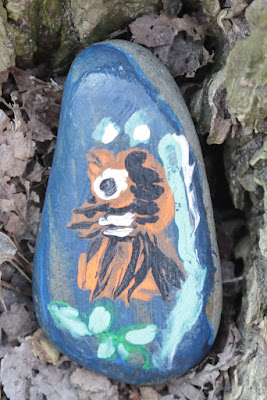I've been home a lot, as have most people. Nonetheless I have been able to get out a bit, and either through good fortune or good planning, have always been at a place where there is nobody else. I'd like to think it is good planning. While the general recommendation is for people to stay home unless going out for groceries or a medical appointment, on those occasions one is far more likely to come in contact with someone else, and therefore much more dangerous than getting out to some relatively remote location where even if there is someone else, you can stay hundreds of metres away.
So I have been able to observe a bit of spring continuing to unfold, although it has been cool enough that it is well behind normal, at least for now.
The McKerrall Woods is off by itself, and the spring wildflowers are doing well. Bloodroot, this first one, is about finished.
Cut-leaved Toothwort is just starting and will be one of the main wildflowers soon.
Dutchman's Breeches is common.
Giant Blue Cohosh has a fairly inconspicuous flower.
Spring Beauty has been out for awhile, but is still in fine form.
Red Trillium is just starting. I usually find it to open a bit before the more commonly seen Large White Trillium, shown following. The white one will likely need a few more days of warmer weather before it really opens up.
On a sunny day, this Yellow Trout Lily, a.k.a. Dog-toothed Violet, will be noticeable. Even when it is not in flower, the forest floor is sometimes covered with their distinctive mottled leaves.
A somewhat unexpected find at this site was a Coyote den. I had seen a Coyote at this woodlot on an earlier visit. It appeared fairly freshly dug. Here's hoping it will provide some photo ops in the future!
At Clear Creek Forest, things are moving along well. In the wetter wooded areas Purple Cress is quite plentiful. The pink/purple flowers and slightly hairy stem are good clues to separate it from others in the genus.
I was pleased to find a bit of this Wild Ginger. I hadn't seen it at Clear Creek before. It is pollinated by ground beetles, so the brownish/maroon coloured flower is usually under last year's leaf litter.
In the vicinity of the old gravel pits now surrounded by well developed woody vegetation, there were a couple of dozen swallows out looking for food. On occasion they would land for a rest, as these two Tree Swallows and single Barn Swallow are doing.
Capturing a swallow in flight is no easy task for a photographer, as they change direction quickly and often. But I managed to capture a couple of Tree Swallows doing their thing.....
....while a Northern Rough-winged Swallow took a rest.
Nearby a couple of Yellow-rumped Warbler were looking for insects as well. This one is an obvious migrant, due to the brighter colours than over wintering Yellow-rumps will have.
A couple of dozen Canada Geese were on the pond, honking their displeasure at my presence. There were several of their mates scattered around the pond, obviously on nests. In another few weeks, the ponds at Clear Creek Forest will likely have dozens of goslings paddling around.
At one point I stopped to check a dead tree stub that had a Pileated Woodpecker nest in it a couple of years ago. At first glance I thought I was looking at the wrong tree, as no obvious hole was visible, and then I realized there was something in the hole. It was a red phase Eastern Screech Owl, as you can tell by the slightly reddish feathers on the head, peeking out catching some sun. The gray colour phase is more common.
Another flying critter was this Narrow-headed Marsh Fly (
Helophilus fasciatus) resting on a dead leaf. It is a type of Syrphid fly that is fairly common from spring until fall.
Moving on, I stopped at the Keith McLean Conservation Lands. With the high water, it looks like it could be great for shorebirds again this year. There were about 17 Dunlin along the shallow edge of 'Lake McLean'.
A couple of dozen Bonaparte's Gulls in various stages of their spring plumage were coming and going.
In the odds and ends category, Northern Flickers are pretty regular wherever you go. I photographed this one at Fletcher Ponds.
A flooded field in southern Chatham-Kent was attractive to this Wilson's Snipe.
At Erieau, you can always count on Double-crested Cormorants, and on this particular day it was no exception. There were at least 50 coming and going to this tree across from the channel. This is the tree where a Neotropic Cormorant was seen periodically last year. Will it return? Time will tell.





















































